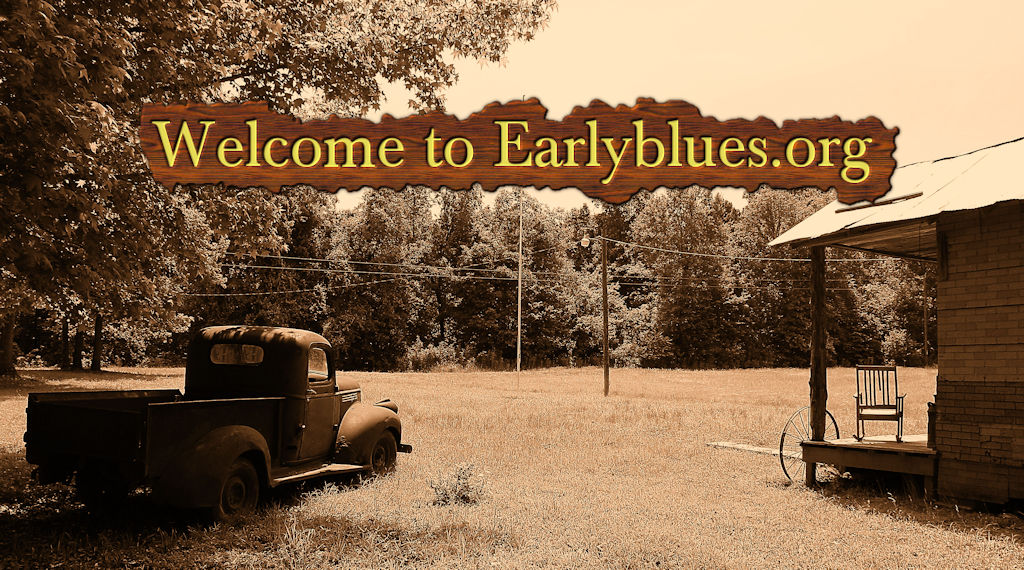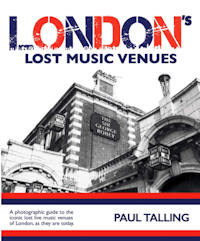Early British Blues Clubs and Venues
Here is a selection of clubs and venues which featured in the early British blues scene, including the artists and bands that performed at the clubs and some details on ‘whatever happened to …’, plus memorabilia and readers memories of attending the clubs. Cick each blue club name for full details.
Details of several of these clubs are being developed and will be added soon.
If you have memories of these clubs and would like to share them here, please email alan@earlyblues.com .
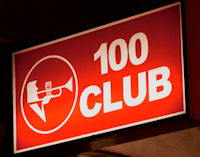 |
100 Club, Oxford Street, London London’s iconic 100 Club has been trading under the same name since 1964 and has put on live music since 1942 as the Feldman Jazz Club amongst other names, earning it the title of the oldest independent venue world wide. Throughout the decades the venue has championed all manors of ground breaking scenes including the blues of Muddy Waters and BB King as well as mod stylings of The Who and The Kinks in the 60s. |
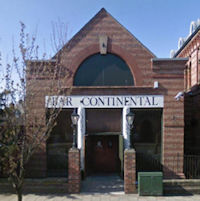 |
Barrow R&B Club, Barrow in Furness, Cumbria The Barrow R&B Club was founded in 2001 by Joyce and Bill Harrison to bring live blues music to a corner of the North West’s Lake District where none previously existed. Over the years many UK and International stars have performed at the club. In 2014, Joyce and Bill received the Lifetime Achievement Award at the British Blues Awards, recognising their tireless support of live music in Barrow. |
 |
Bluesday R&B Club at the Railway Hotel, Harrow The Bluesday Rhythm and Blues Club ran from 1962 to 1964 and was located at the Railway Hotel, a Victorian hotel and public house associated with Harrow and Wealdstone Station. Owned by blues and harp legend, Cyril Davies, the club was dedicated to showcasing budding bands. Within a month of opening, the club boasted 200 members and the club became so successful that hugely popular TV show, ‘Ready Steady Go’ chose the venue for its quest to find the ‘the next Beatles’ – a show named ‘Ready Steady Win’. |
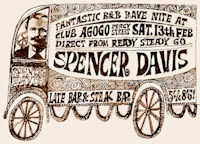 |
Club-A-Gogo was a Newcastle upon Tyne nightspot back in the 1960’s. Created by entrepreneur Mike Jeffery (who later managed The Animals) the club was situated in Percy Street, not too far from the famous football ground, St James’ Park. A narrow doorway led you up a couple of flights of stairs (the club was above the Corporation Bus canteen) where there were two rooms. On the left was the Young Set and on the right, the supposedly more sophisticated Jazz Lounge. |
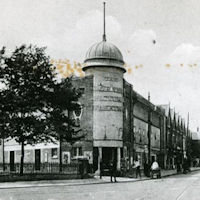 |
Club Noreik, Tottenham, London Club Noreik was located at the Corner Picture Theatre located in the north London inner city district of South Tottenham, on the south west corner of Seven Sisters Road at the junction of Tottenham High Road. When the theatre closed on 27th August 1960 it was converted into a music club, named the Noreik Club, hosting many ‘name’ stars of their day. |
 |
The Country Club, 210a Haverstock Hill, London Behind Belsize Park Tube station was Club IROKO, owned by Nigerian master drummer Ginger Johnson. Previously the Hampstead Tennis & Country Club it hosted a mod club in the 1960s moving into R&B and prog rock – Soft Machine, Jimi Hendrix, the Rolling Stones, Elton John, the Yardbirds all played there – it was bought and renamed by Johnson in the 1970s. |
 |
Crawdaddy Club, Richmond, London The Crawdaddy Club was a music venue in Richmond, Surrey, England, which started in 1963. The Rolling Stones were its house band in 1963; they were followed by The Yardbirds. Several other seminal British blues and rhythm and blues acts also played there. |
 |
The club opened in 1960 and ran for around 4 years. Initially the Downbeat was a jazz venue but towards the end of its life it featured mainly Rhythm & Blues bands. The club was a very basic upstairs room, the walls festooned with posters and a tiny stage at one end. Saturday was the highlight of the week, when the sessions went on all night, earning it a reputation as a den of iniquity. This broadened its appeal to the city’s young sensation seekers, and so the jazz quintet was replaced by the more rebellious sounds of The Animals. |
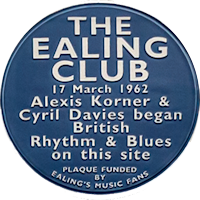 |
Ealing Blues Club, Ealing, London The opening on 17 March 1962 of the Ealing Blues Club by Alexis Korner and Cyril Davies in March 1962, is generally regarded as the pivotal moment when British Blues developed its own identity. British musicians played the blues and were given an opportunity to see other British artists playing the music for the first time. Prior to this date the growing interest in the Blues had been fostered by Jazz musicians, such as Chris Barber who had brought some of the leading Black American artists to the U.K. for the first time. By the end of 1962, the club had overseen the creation of the Rolling Stones who were brought together by Alexis Korner and played there over 20 times. Eric Clapton, Rod Stewart and Pete Townshend played Ealing, as did many other members of future bands that would later take the rawer sound of rock to the world. |
 |
Eel Pie Island Club, Twickenham, London It was trumpeter Brian Rutland of The Grove Jazz Band who first had the idea of starting a Jazz Club at The Eel Pie Island Hotel in 1956. Soon after, Arthur Chisnall, who owned an antiques shop in Kingston, became involved in organising weekly dances there. Arthur brought fame to the Eel Pie Island Jazz Club as a result of his social work in giving young people a voice, and bringing in name jazz acts like Ken Colyer, Chris Barber, Kenny Ball and George Melly. |
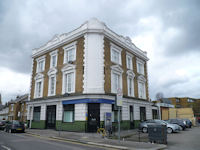 |
The Fishmongers Arms, Wood Green, London The Fishmongers Arms is a former public house on the corner of Trinity Road and High Road, Wood Green, in the London Borough of Haringey. It was known as O’Rafferty’s when it closed after 2000. At the rear of the pub was the Bourne Hall, which the venue for the Wood Green Jazz Club,. The club later became The Barracuda, and in 1971 Fagans. During the 1960s the pub was a rock music venue. It hosted early performances by musicians and bands that would go on to become famous, including John Mayall’s Blues Breakers, Cream, Zoot Money, Graham Bond, Brian Auger, Julie Driscoll, Long John Baldry, Joe Cocker, Rod Stewart, Fleetwood Mac, Ten Years After, The Groundhogs, The Kinks, Led Zeppelin, Jethro Tull, and Pink Floyd. |
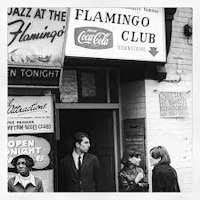 |
The Flamingo Club, Soho, London The Flamingo Club was located at 33–37 Wardour Street Soho, London, between 1952 and 1969. It played an important role in the development of British rhythm and blues and jazz. During the 1960s, the Flamingo was one of the first clubs to employ fully amplified stage sound and used sound systems provided by ska musicians from the Caribbean. The club had a wide social appeal and was a favourite haunt for musicians, including the Beatles. |
 |
Goin’ Up The Country Blues Club (formerly Hooker Blues), Worthenbury, North Wales Hooker Blues Club was formed in November 1997 after dentist Pete Evans, having visited Chicago with Wrexham Rugby Club, decided that as there was not a blues club in north Wales, it would be an ideal opportunity to promote live blues music and to make money for the rugby club. The first nationally known band to appear in february 1998 was The Producers when a sell out 200 crowd proved that Hookers had arrived. The first American artist soon to follow was Deacon Jones, John Lee Hooker’s band leader and accomplished organist who had made his name with Freddie King. He brought some autographed photos from John Lee who was thrilled to hear that a club had been named after him and. a Hookers T shirt was taken by Deacon to present to John Lee. In the following years the club grew from strength to strength presenting all the biggest names in British Blues – The Blues Band, Connie Lush and Blues Shouter, Nine Below Zero, The Hamsters, Otis Grand, The Producers, The Nightporters, Paul Lamb and The Kingsnakes etc. and American artists who have graced Hookers stage include Jimmy Dawkins, Kenny Blues Boss Wayne, Jimmy Burns , Byther Smith, R.J. Mischo, Fred James, Mojo Buford, Eric Sardinas, Studebaker John and Lazy Lester. |
 |
Harringay Bluesville R&B Club at the Manor House Pub, London During the 1960s The Bluesville R&B Club at The Manor House pub ‘punched above its weight’: The Rolling Stones, The Animals, The Who, The Jimi Hendrix Experience, John Mayall, Jimmy Cliff, Cream and Fleetwood Mac all performed in the nightclub. |
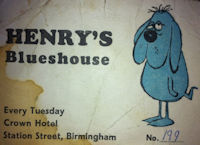 |
Henry’s Blueshouse, Birmingham The original Henry’s Blueshouse was a regular live music night that ran in Birmingham from 1968-1970, promoted by Jim Simpson through his Big Bear Music company. In the late 1960s, Jim Simpson was managing a number of local bands, including Bakerloo Blues Line, and decided to launch a weekly blues club as a platform for the band. Held on Tuesday nights the upstairs room of The Crown on Station Street in Birmingham city centre, Henry’s became known as the first progressive music club in the UK outside of London. The club featured a range of touring British and Irish rock bands who would later go on to gain worldwide recognition, including Status Quo, Thin Lizzy, Jethro Tull, and Judas Priest. In addition, future Led Zeppelin members Robert Plant and John Bonham were regulars at Henry’s Blueshouse, and would often get on stage to jam with the booked performers. |
 |
Klooks Kleek Club at the Railway Hotel, West Hampstead, London Klooks Kleek was a jazz and rhythm n’ blues club at the Railway Hotel, West Hampstead, North West London. Named after a 1956 album by jazz drummer Kenny Clarke entitled Klook’s Clique (Savoy Records 12006), the club opened on 11 January 1961 with special guest Don Rendell (tenor sax) and closed nine years later on 28 January 1970 after a session by drummer Keef Hartley’s group. There were over 1200 sessions at Klook’s Kleek, around 300 of them featuring jazz and the remainder rhythm ‘n’ blues. Zoot Money, Ten Years After, John Mayall and Graham Bond recorded live albums at KK. The British blues and rhythm and blues boom of the early 1960s brought to the club many living legends. |
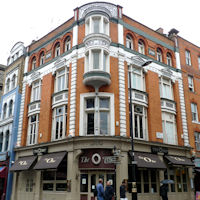 |
London Blues and Barrelhouse Club, Soho, London The London Blues and Barrelhouse Club ran between 1957 and 1961 at the Round House public house at the junction of Wardour Street and Brewer Street in Soho, London. Established by Cyril Davies and Alexis Korner, it hosted many visiting American blues performers and was an important catalyst in developing British blues music, R&B, and ultimately British rock music. |
 |
Marquee Club, Oxford Street, London The Marquee Club was a music venue first located at 165 Oxford Street in London, when it opened in 1958 with a range of jazz and skiffle acts. Its most famous period was from 1964 to 1988 at 90 Wardour Street in Soho, and it finally closed when at 105 Charing Cross Road in 1996, though the name has been revived unsuccessfully three times in the 21st century. It was always a small and relatively cheap club, located in the heart of the music industry in London’s West End, and used to launch the careers of generations of rock acts. It was a key venue for early performances by bands who were to achieve worldwide fame in the 1960s and remained a venue for young bands in the following decades. It was the location of the first-ever live performance by the Rolling Stones on 12 July 1962. |
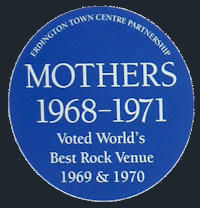 |
Mothers Club, Erdington, Birmingham ‘Mothers’ (formerly the Carlton Ballroom) was a club in the Erdington district of Birmingham, West Midlands, during the late 1960s and early 1970s. It opened above an old furniture store in Erdington High Street on 9 August 1968. The club, run by John ‘Spud’ Taylor and promoter Phil Myatt, closed its doors on 3 January 1971. Between those dates more than 400 acts performed there, many of whom went on to greater success. Some of the other well-known rock bands and artists to play Mothers include: Family, Fleetwood Mac, John Mayall’s Bluesbreakers, Eclection, Edgar Broughton Band, Free, Roy Harper, Blodwyn Pig, Strawbs, Quintessence, Steppenwolf, the Deviants, Jethro Tull, Jon Hiseman’s Colosseum, Skid Row (with Gary Moore), the Nice, Tyrannosaurus Rex, Elton John, King Crimson, Led Zeppelin, The Chicago Transit Authority, Moby Grape, Canned Heat and the Bonzo Dog Doo-Dah Band. Mothers was voted the number one rock venue in the world by America’s Billboard magazine. John Peel, a regular DJ at the club, was quoted as saying: “People are amazed to hear that for a few years the best club in Britain was in Erdington.” |
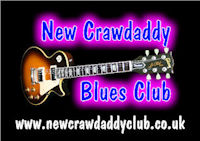 |
New Crawdaddy Blues Club, Essex Named in honour of the famous Richmond venue that spawned so much of 60’s blues boom, such as the Rolling Stones. It ran for 20 years before closing down. |
 |
Ricky-Tick Club, Windsor, Berkshire The Ricky-Tick was an influential 1960s rhythm & blues club in Windsor, Berkshire, England, host to many important acts such as The Rolling Stones, The Who, Jimi Hendrix, Pink Floyd and Cream. It was set up as an R&B venue after founder Jon Mansfield saw the success in early 1962 of the Ealing Club. |
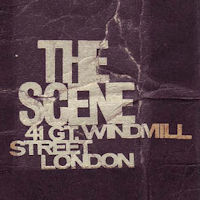 |
The Scene Club was a 1960s music venue in Ham Yard, 41 Great Windmill Street, Soho, London. The club opened in 1963 and was associated with the mod youth subculture. Bands that appeared at the club included the Rolling Stones and The Who. |
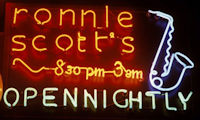 |
Ronnie Scott’s Jazz Club, Soho, London Ronnie Scott’s Jazz Club is a jazz club that has operated in Soho, London since 1959. The club opened on 30 October 1959 in a basement at 39 Gerrard Street in London’s Soho district. It was set up and managed by musicians Ronnie Scott and Pete King. In 1965 it moved to a larger venue nearby at 47 Frith Street. Jimi Hendrix’s last public performance was at Ronnie Scott’s, in 1970. |
 |
Studio 51 (aka Ken Colyer Club), London The basement premises in Great Newport Street were owned by Vi Highland, and originally known as the Studio. During 1950-51 various jazz clubs were held on different nights of the week. Then from May 1951 five nights of the week were given over to modern jazz and all named Studio 51 under the musical direction of Joe Muddel. When Studio 51 was created the Crane River Band retained its Monday night slot. After Ken Colyer’s return from his New Orleans trip, a club in his name started on Monday nights from 1954. With the trad Jazz boom the Ken Colyer Club’s one night expanded to four, and modern Jazz was dropped. The Ken Colyer Club and not Studio 51 was the commonly used description of the venue. Then in the 1960s like many other Jazz venues, Rhythm and Blues took over. Arthur Big Boy Crudup performed here, as did the Rolling Stones (who had a residency in 1963), John Mayall and the Yardbirds. |
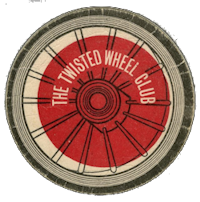 |
Twisted Wheel Club, Manchester The nightclub was founded by the brothers Jack, Phillip and Ivor Abadi as a blues and soul live music coffee bar/dance club. The original location of the club was on Brazennose Street, between Deansgate and Albert Square, Manchester. This was the rhythm and blues mod venue, with Roger Eagle as DJ. The last all-nighter at the Brazennose St. venue was 11 September 1965 with John Mayall’s Bluesbreakers (featuring Eric Clapton) headlining. The club, along with Roger Eagle as DJ, then re-located to 6 Whitworth Street opening on Saturday 18 September with The Spencer Davis Group (featuring Steve Winwood) as headliners. |
more coming soon …
__________________________________________________________
Further London based club and venue information may be in the following book:
